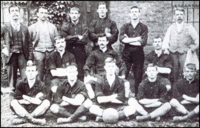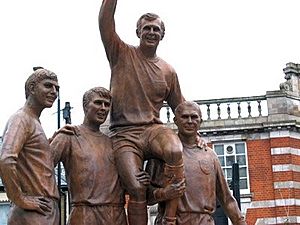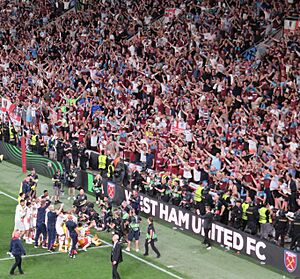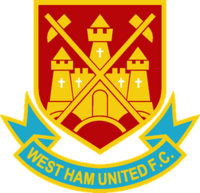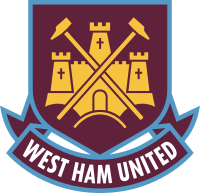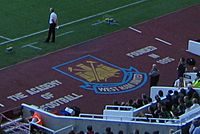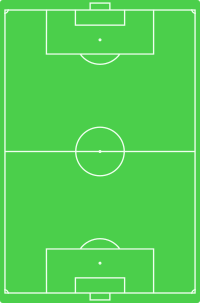West Ham United F.C. facts for kids
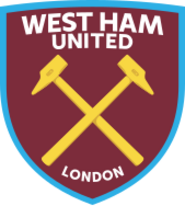 |
|||
| Full name | West Ham United Football Club | ||
|---|---|---|---|
| Nickname(s) | The Irons The Hammers |
||
| Short name | West Ham | ||
| Founded | 29 June 1895, as Thames Ironworks 5 July 1900, as West Ham United |
||
| Ground | London Stadium | ||
| Capacity | 62,500 | ||
| Owner(s) | David Sullivan (38.8%) Daniel Křetínský (27%) Vanessa Gold (25.1%) J. Albert "Tripp" Smith (8%) Other investors (1.1%) |
||
| Co-chairmen | David Sullivan and Vanessa Gold | ||
| Head coach | Graham Potter | ||
| League | Premier League | ||
| 2018–19 | Premier League, 10th of 20 | ||
|
|
|||
West Ham United Football Club is a professional football team from East London, England. They play in the Premier League, which is the top football league in England. The team moved to the London Stadium in 2016, after playing for many years at their old home, the Boleyn Ground.
West Ham United started in 1895 as Thames Ironworks. They became West Ham United in 1900. The team joined the Football League in 1919. They were promoted to the top league in 1923. That same year, they played in the first FA Cup final at Wembley.
West Ham United has won several important trophies. They won the FA Cup three times (in 1964, 1975, and 1980). In Europe, they won the European Cup Winners' Cup in 1965. They also won the Conference League in 2023. West Ham is one of only a few clubs that have never dropped below the second-highest league in English football. Their best league finish was third place in 1985–86.
Three West Ham players were part of the England team that won the 1966 World Cup. These were captain Bobby Moore, and goal scorers Geoff Hurst and Martin Peters. West Ham has a long-standing rivalry with Millwall. West Ham's team colours are claret and sky blue. They started using these colours in the early 1900s.
Contents
Club History
How West Ham Started
West Ham United began in 1895 as Thames Ironworks F.C.. This was the team for the Thames Ironworks and Shipbuilding Company. This company built many ships, including the famous HMS Warrior. The team was started by foreman Dave Taylor and owner Arnold Hills.
The team played as amateurs at first. Many players worked at the ironworks. Some were ship firemen, clerks, or boilermakers. They wore dark blue kits at first. This was because Mr. Hills had been a student at Oxford University. Later, they changed to sky blue shirts and white shorts.
Thames Ironworks won the West Ham Charity Cup in 1895. They also won the London League in 1897. In 1898, they became a professional team. They joined the Southern League Second Division. They quickly moved up to the First Division.
In June 1900, Thames Ironworks F.C. closed down. But it quickly reopened on July 5, 1900, as West Ham United F.C. This new name showed that the team was from the West Ham area of London. Because of their beginnings as a "works team," fans still call them "the Irons" or "the Hammers."
Early Years (1901–1961)
West Ham United joined the Western League in 1901. They also kept playing in the Southern Division 1. In 1907, West Ham won the Western League Division 1B. They then beat Fulham to become the Western League Overall Champions. The club played at the Memorial Grounds in Plaistow. In 1904, they moved to the Boleyn Ground stadium in Upton Park.
West Ham's first game at their new home was against their rivals, Millwall. West Ham won 3–0 in front of 10,000 fans.
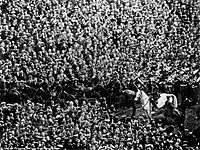
In 1919, West Ham joined the Football League Second Division. They were promoted to the First Division in 1923. That year, they also reached the first ever FA Cup final at the old Wembley Stadium. This game was famous as the "White Horse final." About 200,000 people came to watch. A police officer on a white horse named "Billie" had to clear the crowd from the pitch. Bolton Wanderers won the final 2–0.
In 1932, the club was moved down to the Second Division. Syd King, who had been the manager for 32 years, left the club. His assistant, Charlie Paynter, took over. Paynter had been with West Ham since 1897. The club spent most of the next 30 years in the second division.
In 1958, former player Ted Fenton helped the club get promoted back to the top league. He also helped develop many future West Ham stars.
The Glory Years (1961–1986)
Ron Greenwood became manager in 1961. He quickly led the club to two big trophies. They won the 1964 FA Cup Final with young Bobby Moore as captain. The next year, they won the European Cup Winners' Cup.
In the 1966 World Cup, three key players for the winning England team were from West Ham. These were captain Bobby Moore, Martin Peters (who scored in the final), and Geoff Hurst (who scored the first hat-trick in a World Cup final). All three players grew up in West Ham's youth team.
There is a "Champions" statue in Barking Road. It honors West Ham's "three sons" who helped England win the 1966 World Cup: Bobby Moore, Geoff Hurst, and Martin Peters.
After Ron Greenwood, John Lyall became team manager in 1974. The team quickly found success. They won the FA Cup in 1975. They were the last team to win the FA Cup with only English players. Lyall also led West Ham to another European Cup Winners' Cup final in 1976. They lost 4–2 to Anderlecht.
In 1978, West Ham was moved down to the Second Division again. But Lyall stayed as manager. He led the team to win the 1980 FA Cup final with a 1–0 win against Arsenal. This was the most recent time a team from outside the top league won the FA Cup. West Ham was promoted back to the First Division in 1981. They achieved their highest-ever league finish of third place in 1985–86.
Ups and Downs (1986–2005)
West Ham was moved down again in 1989. Manager John Lyall left the club after 34 years. After Lyall, Lou Macari was briefly manager. He was replaced by former player Billy Bonds. In Bonds' first full season (1990–91), West Ham was promoted back to the First Division. However, they were moved down again after only one season.
In 1992–93, West Ham bounced back. They finished second in their league and were promoted to the Premier League. Harry Redknapp became manager in 1994. His time as manager was known for many player changes. The team played attractive football and had good success.
In 1999, West Ham finished fifth in the Premier League. This was their highest position in the top league since 1986. They also won the Intertoto Cup that year. This helped them qualify for the 1999–2000 UEFA Cup.
In 2001, Harry Redknapp was fired. Glenn Roeder became the new manager. In his first season, the team finished seventh. But the next season, West Ham was moved down to the second tier. Many top players left the club. Roeder was sacked in August 2003.
Alan Pardew became manager in October 2003. He worked to rebuild the team. In his first season, they reached the playoff final but lost. His new players helped West Ham finish sixth the next season. They then beat Preston North End 1–0 in the 2005 playoff final. This secured their return to the Premier League.
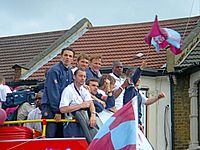
Final Years at Boleyn and New Stadium (2005–2016)
When they returned to the top league, West Ham finished ninth. A big moment in the 2005–06 season was reaching the FA Cup final. They played against Liverpool and lost in a penalty shootout after a 3–3 draw.
In August 2006, West Ham signed Carlos Tevez and Javier Mascherano. The club was later bought by an Icelandic group. Manager Alan Pardew was sacked and replaced by Alan Curbishley. The Premier League investigated the signings of Mascherano and Tevez. West Ham was fined £5.5 million in April 2007. However, they avoided a points deduction. West Ham avoided being moved down by winning seven of their last nine games. They beat Manchester United 1–0 on the last day of the season.
In the 2007–08 season, West Ham stayed in the top half of the league. Manager Alan Curbishley resigned in September 2008. Gianfranco Zola became the club's first non-British manager. In the 2008–09 season, West Ham finished ninth.
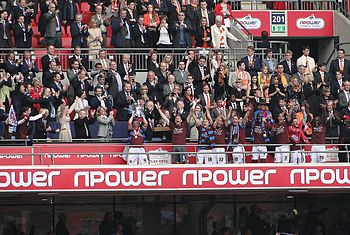
The 2009–10 season was tough. West Ham struggled against being moved down. They secured their survival with two games left. In August 2009, the club faced financial problems. Avram Grant became manager in June 2010. West Ham's poor form continued. They were moved down to the Championship on May 15, 2011. Grant was sacked.
Sam Allardyce was appointed manager in June 2011. The club finished third in the 2011–12 Football League Championship. They won their play-off semi-final against Cardiff City. They then beat Blackpool 2–1 in the final at Wembley on May 19, 2012. This secured their return to the Premier League.
On March 22, 2013, West Ham signed a 99-year lease for the Olympic Stadium. They planned to use it as their home ground from the 2016–17 season. West Ham finished 10th in the 2012–13 Premier League. In 2013–14, they finished 13th. Sam Allardyce's contract was not renewed in May 2015.
On June 9, 2015, former West Ham player Slaven Bilić became manager. In his first season, West Ham finished 7th in the Premier League. They broke several club records for points and goals. This season was also their last at the Boleyn Ground. They moved to the London Stadium the next season.
London Stadium and European Success (2016–Present)
After Manchester United won the 2016 FA Cup final, West Ham qualified for the Europa League. In their first season at the London Stadium, the team finished 11th. They also lost their star player, Dimitri Payet. The team had a poor start to the next season. Bilić was sacked in November 2017. David Moyes replaced him. The team avoided being moved down and finished 13th. Moyes' contract was not renewed.
On May 22, 2018, Manuel Pellegrini became the new manager. In his first season, the Hammers finished 10th. But after a poor start to the next season, Pellegrini was sacked in December 2019. David Moyes returned for his second time as manager.
On July 22, 2020, the club secured their Premier League status. West Ham's form improved in the 2020–21 season. They finished 6th and qualified for the 2021–22 UEFA Europa League group stages. Moyes signed a new three-year contract.
West Ham had a strong start to 2022. They reached their first European quarter-final in 41 years. They then reached their first European semi-final since 1976. They were knocked out of the Europa League by Eintracht Frankfurt. At the end of the 2021–22 Premier League season, West Ham qualified for European football again. They entered the UEFA Europa Conference League. This season was also Mark Noble's last as a West Ham player. He retired after 18 years with the club.
The 2022–23 season was mixed. The club finished 14th in the Premier League. Manager David Moyes faced pressure. However, they did very well in the Europa Conference League. The club reached the final without losing a game. They won the competition, beating Fiorentina 2–1. This was their first major trophy since 1980. It was also their first European trophy in 58 years.
David Moyes left the club in 2024. He had led West Ham to three European seasons in a row. On May 23, Julen Lopetegui was named as his replacement. He was sacked on January 8, 2025. On January 9, Graham Potter was appointed as head coach.
Club Crest
Hammers on the Badge
The main part of the West Ham badge is a pair of crossed rivet hammers. These tools were used in the shipbuilding industry. The areas around the Thames Ironworks were full of the sound of hammers.
Teams of five workers used these hammers to build ships. Two men outside the ship would use rivet hammers to flatten the hot rivets. This secured the large metal plates of the ship together.
The crossed hammers are also on the coat of arms of the London Borough of Newham.
The Tower on the Badge
A yellow or white tower was sometimes added to the badge from the 1950s. This tower was meant to represent Anne Boleyn's Tower. This was a notable part of Green Street House, which stood next to the Boleyn Ground. Green Street House was also known as Boleyn Castle.
Other reasons for the tower might include:
- To show the link to the Castle Swifts team.
- The look of the Engineering Department at the Thames Ironworks looked like a castle.
- The club's song, "I'm forever blowing bubbles," talks about "building castles high."
- The White Tower of the Tower of London represents East London.
- To honor the 'West Ham Pals', a group of soldiers from Stratford who fought in World War I. Their war cry was "Up the Hammers."
The Shield Shape
A shield has been used in many versions of the club badge. The shape of the 2016 badge looks like the side view of the hull of HMS Warrior. This was a famous ship built by Thames Ironworks.
Badge Changes Over Time
The club crest was updated in the late 1990s. The yellow castle became wider. The new badge was designed to look more solid. When the club rebuilt the west stand of the Boleyn Ground, the "castle" from the badge was built into the main entrance.
A new badge was introduced after the 2015–16 season. This was when the club moved to the Olympic Stadium. The new badge removed the Boleyn Castle because the club was moving. It only kept the crossed hammers. The word "London" was added below the hammers. This was to show the club's place on the world stage.
Team Colours
The team's first colours were dark blue. This was because Thames Ironworks chairman Arnold Hills had studied at Oxford University. However, the team also used claret and sky blue, which were the company's own colours. They also used sky blue or white kits.
The Irons permanently adopted claret and blue for their home colours in 1903.
One story says that Thames Ironworks player Charlie Dove got the Aston Villa kit from William Belton. Belton was a sprinter who won a race against four Aston Villa players. When they couldn't pay him, one player offered a full team kit as payment. This story is often debated.
West Ham United kept the claret and blue design. They also continued to use their older colours for their away kits.
Supporters and Rivalries
West Ham Supporters
I'm forever blowing bubbles,
Pretty bubbles in the air.
They fly so high, nearly reach the sky,
Then like my dreams they fade and die.
Fortune's always hiding,
I've looked everywhere ...
I'm forever blowing bubbles,
pretty bubbles in the air.
West Ham supporters are famous for singing their team's song, "I'm Forever Blowing Bubbles." Former manager Charlie Paynter introduced it in the late 1920s. A famous soap commercial with a child blowing bubbles was popular then. This child looked like a young player named Billy J. "Bubbles" Murray.
A school headmaster, Cornelius Beal, wrote special words to the tune of "I'm Forever Blowing Bubbles." He did this when a player had a good game. Beal was a friend of Paynter. Through this connection, West Ham fans started singing the song before home games.
The 1975 FA Cup version of the song is always played before home games. The crowd joins in and continues singing after the music stops. Since the 1950s, fans have also sung the East London pub song Knees Up Mother Brown.
Fans also adapt popular songs for players or events. For example, they sang Paolo Di Canio's name to the tune of "La donna è mobile." They also sang "That's Zamora" for former striker Bobby Zamora. When players come onto the pitch, many bubble machines fill the stadium with bubbles.

Club Rivalries
West Ham has strong rivalries with other clubs. Many of these are with other London teams. These include Tottenham Hotspur and Chelsea. The rivalry with Tottenham has grown because some players have moved between the clubs.
The oldest and strongest rivalry is with Millwall. Both teams were started by workers from local companies. Their early histories are connected. The rivalry became more intense in the 1920s during a workers' strike. Millwall fans' companies refused to support the strike. This caused bad feelings between the two groups.
The rivalry between West Ham and Millwall has sometimes involved violence. The teams played each other in the 2009–10 League Cup on August 25, 2009. This was the first time they had played in four years. There were clashes between fans outside the stadium.
Team Nicknames
The team and its supporters are known as The Hammers. This nickname comes from the club's origins as Thames Ironworks. They are also called The Irons.
Stadium
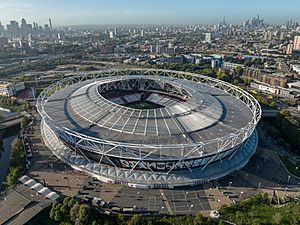
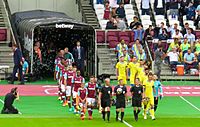
Until 2016, West Ham played at the Boleyn Ground, also known as Upton Park. This stadium was in Newham, East London. It had a capacity of 35,016 fans. West Ham had played there since 1904. Before that, as Thames Ironworks, they played at Hermit Road and Browning Road. They then moved to the Memorial Grounds in 1897.
The club wanted to move to the Olympic Stadium after the 2012 Summer Olympics. In February 2010, the British Olympic Minister said West Ham would not get the stadium. It would be used for track and field events. However, West Ham and the Newham London Borough Council submitted a plan to use the stadium. They proposed a 60,000-seat stadium that would keep an athletics track.
On September 30, 2010, the club formally submitted its bid for the Olympic Stadium. On February 11, 2011, West Ham was chosen as the preferred club to move into the stadium. This decision was unanimous but caused controversy. Other clubs, like Tottenham Hotspur, had also bid for the stadium. Tottenham and Leyton Orient challenged the decision in court. Their appeals were rejected.
On March 3, 2011, West Ham's move to the Olympic Stadium was approved by the British government. On June 8, 2011, it was confirmed that the Westfield Shopping Centre was discussing naming rights for the new stadium. West Ham planned to move from the Boleyn Ground in the 2014–15 season.
In August 2011, an investigation supported the decision to give West Ham the Olympic Stadium. However, Tottenham and Leyton Orient continued their legal challenge. On October 11, 2011, the deal to give West Ham the Olympic Stadium fell apart. The government decided the stadium would stay publicly owned. Six days later, Tottenham and Leyton Orient ended their legal challenge.
A new process to choose a tenant began. West Ham immediately planned to become tenants. By March 2012, West Ham was one of four bidders. On March 22, 2013, it was announced that West Ham had signed a 99-year lease for the Olympic Stadium. The club planned to move in before the start of the 2016–17 season.
The Academy of Football
West Ham is known as "The Academy of Football." This name is even on the new stadium's front. It refers to the club's youth development system. This system was started by manager Ted Fenton in the 1950s. Many international players have come from this system.
Most famously, three players from West Ham were on the England team that won the World Cup in 1966. These were club legend Bobby Moore, Martin Peters, and Geoff Hurst. They scored all of England's goals in the 4–2 victory. Other academy players who played for England include Trevor Brooking, Alvin Martin, and Declan Rice.
Since the late 1990s, players like Rio Ferdinand, Frank Lampard, Joe Cole, and Michael Carrick started their careers at West Ham. They later played for other big clubs. More recently, players like Mark Noble and James Tomkins have come from the Academy.
West Ham has sometimes struggled to keep these talented players. This is often due to financial reasons. Between 2000 and 2011, the club produced eight England players. This was as many as Manchester United. Much of the Academy's success is thanks to Tony Carr. He was West Ham's youth coach for many years.
Players
Current Squad
|
|
Retired Numbers
West Ham United has retired two shirt numbers to honor special players:
- 6 for Bobby Moore, a defender who played from 1958 to 1974.
- 38 for Dylan Tombides, a striker who played from 2010 to 2014.
Club Captains
| Dates | Name |
|---|---|
| 1895–97 | |
| 1897–99 | |
| 1899 | |
| 1899–01 | |
| 1901–03 | Unknown |
| c.1903–04 | |
| 1904–07 | |
| 1907–11 | |
| 1911–14 | |
| 1914–15 | |
| 1915–22 | |
| 1922–25 | |
| 1925–26 | |
| 1926–28 | |
| 1928–32 | |
| 1932–37 | |
| 1937–46 | |
| 1946–51 | |
| 1951–57 | |
| 1957–60 | |
| 1960–62 | |
| 1962–74 | |
| 1974–84 | |
| 1984–90 | |
| 1990–92 | |
| 1992–93 | |
| 1993–96 | |
| 1996–97 | |
| 1997–2001 | |
| 2001–03 | |
| 2003 | |
| 2003–05 | |
| 2005–07 | |
| 2007–09 | |
| 2009–11 | |
| 2011–15 | |
| 2015–22 | |
| 2022–23 | |
| 2023–24 | |
| 2024– |
West Ham Dream Team
In a 2003 book, The Official West Ham United Dream Team, fans voted for their all-time favorite Hammers players. Here's the team they chose:
| 1 | GK | Phil Parkes | |
| 2 | DF | Ray Stewart | |
| 3 | DF | Julian Dicks | |
| 4 | MF | Billy Bonds | |
| 5 | DF | Alvin Martin | |
| 6 | DF | Bobby Moore (captain) | |
| 7 | MF | Martin Peters | |
| 8 | MF | Trevor Brooking | |
| 9 | FW | Geoff Hurst | |
| 10 | FW | Paolo Di Canio | |
| 11 | MF | Alan Devonshire |
Hammer of the Year Award
The 'Hammer of the Year' award is given to the best player each season. Fans vote for the winner. Trevor Brooking won this award three times in a row (1976, 1977, 1978). He has won it the most times, with five awards in total. Bobby Moore, Billy Bonds, and Julian Dicks have each won it four times.
|
|
Lifetime Achievement Award
In 2013, West Ham United started a new award. It is called the West Ham United Lifetime Achievement Award. It honors people who have made a huge difference to the club.
The first award went to Billy Bonds in 2013. He played the most games for the club. In 2014, Sir Trevor Brooking received the award. He won the Hammer of the Year award five times. Martin Peters received the award in 2015. Sir Geoff Hurst was honored in 2016. He is the club's second-highest goal scorer. Bobby Moore received the award in 2017. Ken Brown received it in 2018. In 2019, Ronnie Boyce was honored.
|
Mark Noble Young Hammer of the Year Award
This award is given to the best young player at West Ham. It was renamed in honor of Mark Noble in 2022. Mark Noble played for the club from 2000 until he retired in 2022. He also won the award himself in 2004.
| Year | Winner |
|---|---|
| 2003 | |
| 2004 | |
| 2005 | |
| 2006 | |
| 2007 | |
| 2008 | |
| 2009 | |
| 2010 | |
| 2011 | |
| 2012 | |
| 2013 | |
| 2014 | |
| 2015 | |
| 2016 | |
| 2017 | |
| 2018 | |
| 2019 | |
| 2020 | |
| 2021 | |
| 2022 | |
| 2023 | |
| 2024 | |
| 2025 |
Club Staff
Staff and Directors
| Position | Name |
|---|---|
| Co-chairman | David Sullivan |
| Co-chairman | Vanessa Gold |
| Vice-chairman | Karren Brady CBE |
| Director | Daniel Křetínský |
| Director | Pavel Horský |
| Director | Peter Mitka |
| Director | Jiří Švarc |
| Director | Jack Sullivan |
| Director | David Sullivan Jr. |
| Director | Daniel Cunningham |
| Non-executive director | Daniel Harris |
| Non-executive director | Tripp Smith |
| Honorary life president | Terry Brown |
| Club secretary | Andrew Pincher |
| Chief finance officer | Andy Mollett |
| Projects & stadium operations director | Philippa Cartwright |
| Executive director, marketing & communications | Tara Warren |
| Club ambassador | Tony Carr MBE |
| Sporting director | Mark Noble |
Coaching Staff
| Position | Name |
|---|---|
| Head coach | Graham Potter |
| Assistant head coach | Bruno Saltor |
| First team coach | Narcís Pèlach |
| First team coach | Billy Reid |
| First team goalkeeper coach | Linus Kandolin |
| Academy manager & head of coaching and player development | Kenny Brown |
| Academy operations and player development manager | Ricky Martin |
| Head of medical services | Richard Collinge |
| First team physiotherapist | Dominic Rogan |
| First team rehabilitation fitness coach | Eamon Swift |
Managers
West Ham United has had 19 permanent managers and three temporary (caretaker) managers in its history.
| Manager | Caretaker Manager | Period | Games | Wins | Draws | Losses | Win % | Main Achievements |
|---|---|---|---|---|---|---|---|---|
| 1901–32 | 638 | 248 | 146 | 244 | 38.87 | Longest-serving manager (31 years). FA Cup runners-up 1923. | ||
| 1932–50 | 480 | 198 | 116 | 166 | 41.25 | |||
| 1950–61 | 484 | 193 | 107 | 184 | 39.87 | Division Two Champions 1957–58. | ||
| 1961–74 | 613 | 215 | 165 | 233 | 35.07 | FA Cup winners 1964, UEFA Cup Winners' Cup winners 1965. League Cup runners-up 1966. | ||
| 1974–89 | 708 | 277 | 176 | 255 | 39.12 | FA Cup winners 1975, 1980. Highest league finish (3rd in Division One 1985–86). UEFA Cup Winners' Cup runners-up 1976. | ||
| 1989–90 | 38 | 14 | 12 | 12 | 36.84 | |||
| 1990 | 1 | 0 | 1 | 0 | 0.00 | |||
| 1990–94 | 227 | 99 | 61 | 67 | 43.61 | |||
| 1994–01 | 327 | 121 | 85 | 121 | 37.00 | UEFA Intertoto Cup winners 1999. Highest Premier League finish (5th, 1998–99). | ||
| 2001–03 | 86 | 27 | 23 | 36 | 31.40 | |||
| 2003 | 14 | 9 | 4 | 1 | 64.29 | |||
| 2003–06 | 163 | 67 | 38 | 58 | 41.10 | Championship Play-off Winners 2005, FA Cup runners-up 2006. | ||
| 2006–08 | 71 | 28 | 14 | 29 | 39.44 | |||
| 2008 | 1 | 0 | 0 | 1 | 0.00 | |||
| 2008–10 | 80 | 23 | 21 | 36 | 28.75 | Club's first non-British manager. | ||
| 2010–11 | 47 | 15 | 12 | 20 | 31.91 | |||
| 2011 | 1 | 0 | 0 | 1 | 0.00 | |||
| 2011–15 | 181 | 68 | 46 | 67 | 37.57 | Championship Play-off Winners 2012. | ||
| 2015–17 | 111 | 42 | 30 | 39 | 37.84 | |||
| 2017–18 | 31 | 9 | 10 | 12 | 29.03 | |||
| 2018–19 | 64 | 24 | 11 | 29 | 37.50 | |||
| 2019–2024 | 231 | 103 | 45 | 83 | 44.59 | UEFA Europa Conference League winners 2023. Highest win percentage of permanent managers. |
||
| 2024–2025 | 22 | 7 | 5 | 10 | 31.82 | |||
| 2025–present | 18 | 4 | 5 | 9 | 22.22 |
Club Ownership
In January 2010, David Sullivan and David Gold bought a 50% share in West Ham. This gave them control of the club. They later bought more shares, increasing their ownership.
In September 2017, American billionaire J. Albert "Tripp" Smith bought 10% of the club's shares. On November 10, 2021, Czech billionaire Daniel Křetínský bought 27% of the shares. This reduced Gold and Sullivan's shares.
Co-chairman David Gold passed away on January 4, 2023. Sullivan became the sole chairman. Seven months later, Gold's daughter Vanessa became joint-chair with Sullivan.
European Record
West Ham United has played in several European competitions.
- European Cup Winners' Cup
- Winners: 1964–65
- Runners-up: 1975–76
- UEFA Conference League
- Winners: 2022–23
- UEFA Intertoto Cup
- Winners: 1999
Honours and Trophies
Domestic Trophies
- League Titles
- Second Division / First Division / Championship (second tier)
- Champions: 1957–58, 1980–81
- Runners-up: 1922–23, 1990–91, 1992–93
- Play-off winners: 2005, 2012
- Second Division / First Division / Championship (second tier)
- Cup Competitions
- FA Cup
- Winners: 1963–64, 1974–75, 1979–80
- Runners-up: 1922–23, 2005–06
- League Cup
- Runners-up: 1965–66, 1980–81
- FA Charity Shield
- Winners: 1964 (shared)
- Runners-up: 1975, 1980
- Football League War Cup
- Winners: 1940
- FA Cup
European Trophies
- European Cup Winners' Cup
- Winners: 1964–65
- Runners-up: 1975–76
- UEFA Conference League
- Winners: 2022–23
- UEFA Intertoto Cup
- Winners: 1999
- Anglo-Italian League Cup
- Runners-up: 1975
Other Titles
- International Soccer League
- Winners: 1963
- London League: 1897–98, 1901–02
- Western League: 1906–07
- London Challenge Cup
- Winners: 9 times (last in 1968–69)
- West Ham Charity Cup: 1896
Club Records and Statistics
Attendance Records
- Highest attendance: 62,478 vs Leeds United, Premier League, May 21, 2023.
- Highest attendance at Boleyn Ground: 42,322 vs Tottenham Hotspur, October 17, 1970.
- Lowest league attendance: 4,373 vs Doncaster Rovers, February 24, 1955.
Transfer Records
- Biggest fee paid for a player: £51.2 million for Lucas Paquetá from Lyon, August 29, 2022.
- Biggest fee received for a player: £100 million for Declan Rice from Arsenal, July 15, 2023.
Record Wins
- Premier League:
- Home: 6–0 vs Barnsley, January 10, 1998.
- Away: 5–0 vs Derby County, November 10, 2007.
- FA Cup:
- Home: 8–1 vs Chesterfield, January 10, 1914.
- League Cup:
- Home: 10–0 vs Bury, October 25, 1983.
- European Cup Winners' Cup:
- Home: 5–1 vs Castilla CF, October 1, 1980.
- UEFA Europa League:
Record Losses
- Premier League:
- FA Cup:
- Away: 0–6 vs Manchester United, January 26, 2003.
- League Cup:
- Away: 0–6 vs Oldham Athletic, February 14, 1990.
- Away: 0–6 vs Manchester City, January 8, 2014.
Player Records
|
Most Appearances
|
Most Goals
|
Images for kids
See also
 In Spanish: West Ham United Football Club para niños
In Spanish: West Ham United Football Club para niños


